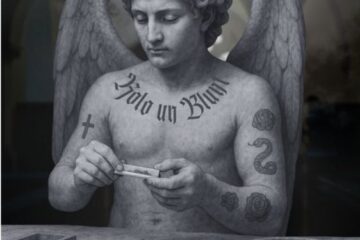Taller Puertorriqueño hosted recently a reception at their Lorenzo Homar Art Gallery in North Philadelphia for the opening of the exhibit Unpacking Hispañola to showcase the work of Dominican artists Scherezade Garcia and Firelei Báez. This exhibition will remain on display through April 2, 2016.
The exhibit is divided into two sections: Deconstructing History, is an exhibit that shows the artists’ re-interpretation of Dominican blackness and its construction at different moments of the country’s national history. The second section is titled Myth in the Making, which shows the artists’ examination of the construction of Dominican identity through religious and folkloric imagery. “This particular show is happening, this particular time, because it ties to the theme of the Schomburg Symposium, which is twenty years, this year. There’s going to be an incredible panel with these artists, and Abigail as the moderator,” said Febo-San Miguel, Executive Director at Taller Puertorriqueño.
“The show is about myth and history or history and myth depending on how you want to interpret it. This show analyzes how the historical narrative is constructed in the Dominican Republic, but also from a U.S. perspective through the work of Dominican American visual artists Scherezade Garcia and Firelei Báez,” said Lapin Dardashti, curator of Unpacking Hispañola. “We’re taught history in a certain way, in a way you don’t think about how the historical narrative is constructed. Both artists create images that complicate the traditional distinctions between myths and historical ‘facts’, questioning the very nature of historical narratives, things that have been erased from the accepted historical narrative, and then to challenge even more of the historical narrative thinking about myth and how that plays into the oral tradition of the Dominican Republic and of other places, so it’s really about thinking about what we are told, and challenging it,” she adds.
“It is really great to have this platform, and to have the parallel in ideas, because these are things that I have been concerned with and have been questioning since I was a little girl, growing up between the U.S. and the Dominican Republic,” said Báez. “The ciguapa has been a theme of Báez’s work since her early career, because the figure challenges societal roles and retains her freedom. The ciguapa is a voluptuous mountain dweller with backwards feet that makes her untraceable. She is traditionally depicted in Dominican folklore as a deceiving female figure. In the wooden panels exhibit, Báez creates an inspiring character that fights obstacles and chooses her own path,” said Lapin Dardashti. “This creature has this flexibility in a society that a lot of times has very strict gender roles,” said Báez. “It’s Been Ours recounts the story of a transforming female figure that embodies a ciguapa and Dominican carnival characters calife, roba la gallina (steal the chicken) and Diablo cojuelo (limping devil). Dominican Carnival emerged in the sixteenth century and became a series of covert acts of resistance against Spanish colonialism and the Catholic Church, reversing accepted norms and incorporating African-derived culture into the public sphere,” said Lapin Dardashti.
In another art piece in this exhibit, “Báez depicts a severed white arm, which is tattooed with an 18th century textile design entitled Triumfa España en las Americas, and neatly placed on an intricate wooden floor. The severed arm in Báez’s complex painting refers to the stereotype of widespread and violent indigenous cannibalism in the Americas that began in the early colonial period, as depicted in Dutch painter Albert Eckhout’s 17th century work from his Brazilian sojourn,” said Lapin Dardashti. “Since the pattern is tattooed on a decapitated white arm, Báez contends that the Spanish colonial system itself underwent extreme violence caused by its own oppressive political system. She further critiques the persistent racial and gendered hierarchies in Latin America that resulted from this very same system.”
Similar to Báez, Garcia puts her own life experiences into her artwork. “After witnessing the destruction of New York and New Jersey caused by Hurricane Sandy in fall 2012, Garcia connects her own personal experience with her provocative thoughts about the history of colonialism and blackness in the Dominican Republic. The Byzantine-like gold background refers to the colonial discovery of gold in the Dominican Republic, which brought an increasing number of African slaves and Spanish colonizers to the region. For Garcia, the mixing of gold and water becomes a method as well as a way to reconsider the history of blackness and its movement throughout the Americas,” said Lapin Dardashti. “I love contradiction, and how your imagination composes that history, I love to discompose and put it together my way, so you can see my need to work in isolated environments in my studio in many of my paintings, yet I do need to engage the community,” said Garcia. At the reception, Garcia tells the audience, “if you take a look, everything that I am talking about is in my work, nothing is simple, it’s full of layers.”
“Garcia and Báez create artworks that are instrumental in representing the diasporic transformations of Dominican immigrants in the United States,” said Lapin Dardashti. “Through a U.S. civil rights perspective, the artists blur and exaggerate dominant racial and gendered boundaries to recreate a specifically Dominican American subjectivity in an alternative space that exposes and critiques pervasive and global inequalities.”




